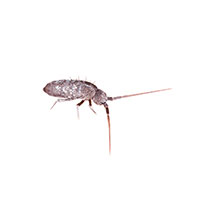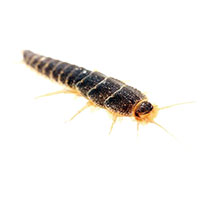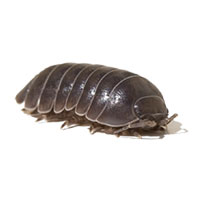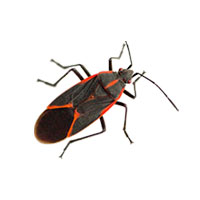Fast Facts![]()
| Color | Whitish-gray and light-colored. |
| Size | 1/32 – 1/8″ in length. |
| Appearance | They do not have wings and cannot fly but can jump several inches. They have a bulbous “humpback” body and a distinctive head with long antennae. |
Springtail Diet
They feed on decaying organic matter, algae, and fungi.
Springtail Habitat
Outdoors, springtails are always found in moist situations and are typically associated with leaf litter, mulch, firewood, landscape timbers, potted plants, and railroad ties. When springtails are found close to the home in high moisture conditions, they may eventually move indoors looking for moisture. Indoors, springtails are found in areas of high moisture and condensation. They are commonly found around plumbing leaks in bathrooms, basements, and kitchens. They can also be found in the soil of overwatered houseplants.
Springtail Life Cycle
Females lay eggs singly or in clusters in moist areas. The immature springtails undergo 5-10 molts before they become adults. The adult continues to molt up to 50 times throughout its life with an increase in size after the 15th molt. Developmental time, from egg to adult, requires two to three months, but sometimes, as long as two years.
Springtail Damage & Signs of Infestation
These nearly invisible bugs do not bite or sting and are generally harmless to humans. Springtails are mostly a nuisance pest, doing little damage to plants. They will chew roots in the soil where they’re located, but they seldom do major damage. When you see large numbers of springtails, it means there is a high moisture problem. Springtails are generally a temporary problem and die when moisture levels are reduced.
Springtail Prevention & Control
Springtail Prevention
Check inside and outside of the house for moisture problems. Moisture causing issues:
- Rain spouts that do not carry water far enough away from the foundation
- Landscapes that slope towards buildings
- Excessive irrigation
- Non-functioning drainage systems around the building
If you see small numbers of springtails, physically remove them by hand or with a vacuum. For larger infestations:
- Dry out wet areas with a fan or dehumidifier
- Remove wet wood, especially if it is moldy
- Make structural changes to correct moisture problems
- Remove or reduce the amount of mulch around the foundation of your home
Springtail Control
Professional Control
A Service Specialist will inspect your property to identify areas that are creating harborages for insects. They will treat the necessary areas which may include the perimeter of the building foundation and possible interior areas (basement, garage, drains, wall voids, sump pumps, bathroom, kitchen, and laundry room) depending on the situation.
DIY Control
Eliminate the moisture source that sustains them. Outdoors, they can be controlled by doing the following:
- Remove harborage areas and storing items off the ground, including debris and rotting wood
- Remove particles of food and concentrations of dust and lint that could serve as a food source
- Seal and caulk gaps and entry points into buildings around siding, windows, doors, pipes, and wires
- Avoid over-watering garden and plants
Need help with Springtails?
We'll call you! Leave your information below.
Pests Belong Outside!
Leave your information below and we will give you a call back.
"*" indicates required fields
*During normal business hours. After hours inquiries will be returned the next business day.






